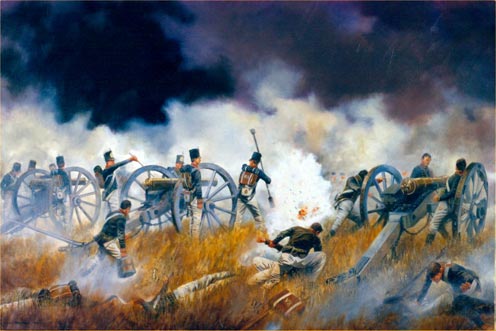| |
« Click on Picture to
Return » |
|
|
 |
|
Capt Sillery's Company, 7th Battalion Royal Artillery at the Battle of Talavera
27-28 July 1809: After crossing the River Douro, the British Army under Sir Arthur Wellesley pressed on into Spain and moved towards Madrid. The Spanish army received a serious check from the French, and to restore the situation Sir Arthur took up a defensive position at Talavera.
The Allied artillery was greatly inferior to the French in numbers (30 guns against 66). Shortly before the battle, Captain CD Sillery was posted to command his brigade of guns (as an artillery battery was then called). This brigade of guns was first engaged on the evening of 27th July in covering the retirement of the army to the defensive position of Talavera. The brigade was opposed to the guns of the enemy whose fire it completely silenced.
In very hot weather on the next day the French made three series of attacks. The first was an attempt to capture high ground on the Allied left, but it was repulsed by the British infantry and Sillery's Company on the flank firing salvoes of case shot. The brigade was on a level piece of ground overlooking a shallow valley, through which ran a stream, over which the French were advancing. The French artillery was deployed on the other side of the stream at a similar height. Then, two more major attacks were made on the right and centre of the Allied position. Captain Sillery in the centre used his 6-pounder guns to great effect.
Sillery’s brigade was opposed to fourteen guns (8-pounders) and six 8 inch howitzers from 6am until noon, when there was a cessation of fire. Shells and cannonballs fell amongst the British and the loss in men and horses was severe. 2nd Captain HB Lane was wounded on the second day when a shell burst under the gun he was pointing, taking a leg off one gunner and killing another two. The British gunners and infantry were suffering from the heat, fatigue and lack of provisions and water.
The Allied artillery was expected to move to fresh gun positions when that would improve the fire support. In the smoke-clouded battles of that time, a short move, made by the gun detachments hauling on the drag ropes, would often result in unexpected, and therefore highly disconcerting, fire being applied to the flank of a column of advancing infantry. It is believed that one third of the casualties inflicted on the enemy were caused by gun fire.
This painting was commissioned by 46 (Talavera) Battery Royal Artillery.
Medium: Oil on Canvas
Printed image size(s): B2 only (58 x 38 cm)
Owner: 46 (Talavera) HQ Battery Royal Artillery
Price(s): £70
|
|
| |
|
|
|
|
|
|
|
|
|
|
|
|
|
|
|
|











